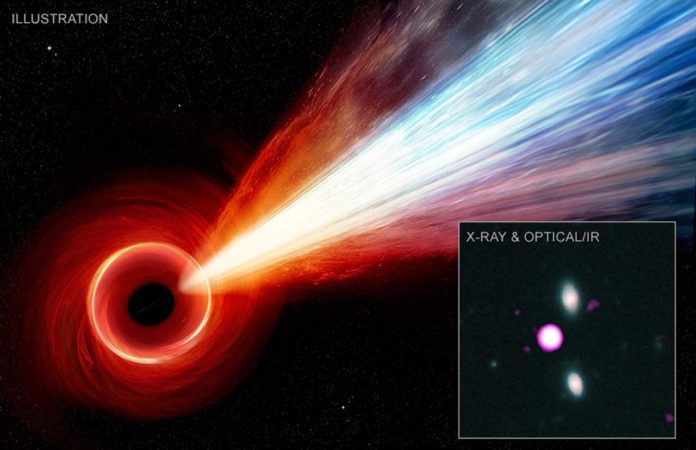Astronomers using NASA’s Chandra X-ray Observatory have detected an extraordinarily long jet of particles from a supermassive black hole named PSO J352.4034-15.3373 (PJ352-15 for short). The black hole is located at the center of a young galaxy in an early universe.
According to astronomers, a jet’s source is a quasar that is one of the two most powerful quasars detected in radio waves in the first billion years after the Big Bang and is about a billion times more massive than the Sun.
If confirmed, it would be the most distant supermassive black hole with a jet detected in X-rays. Its discovery could explain how the biggest black holes formed at a very early time in the Universe’s history.
Astronomers observed the black hole for a total of three days using the sharp vision of Chandra. They detected x-ray emission about 160,000 light-years away from the quasar and the same direction as much shorter jets seen in radio waves.
PJ352-15 breaks a couple of various astronomical records: the longest jet previously observed from the first billion years after the Big Bang was only about 5,000 light-years in length. It is also about 300 million light-years farther away than the most distant X-ray jet recorded before it.
Co-author Eduardo Bañados of the Max Planck Institute for Astronomy (MPIA) in Heidelberg, Germany, said, “The length of this jet is significant because it means that the supermassive black hole powering it has been growing for a considerable period. This result underscores how X-ray studies of distant quasars provide a critical way to study the growth of the most distant supermassive black holes.”
“The light detected from this jet was emitted when the Universe was only 0.98 billion years old. At this point, the intensity of the cosmic microwave background radiation (CMB) leftover from the Big Bang was much greater than it is today.”
Co-author Daniel Stern, also of JPL, said, “Our result shows that X-ray observations can be one of the best ways to study quasars with jets in the early Universe. Or to put it another way, X-ray observations in the future may be the key to unlocking the secrets of our cosmic past.”
Journal Reference:
- Thomas Connor et al., Enhanced X-ray Emission from the Most Radio-Powerful Quasar in the Universe’s First Billion Years, arXiv:2103.03879v1 [astro-ph.GA], arxiv.org/abs/2103.03879
